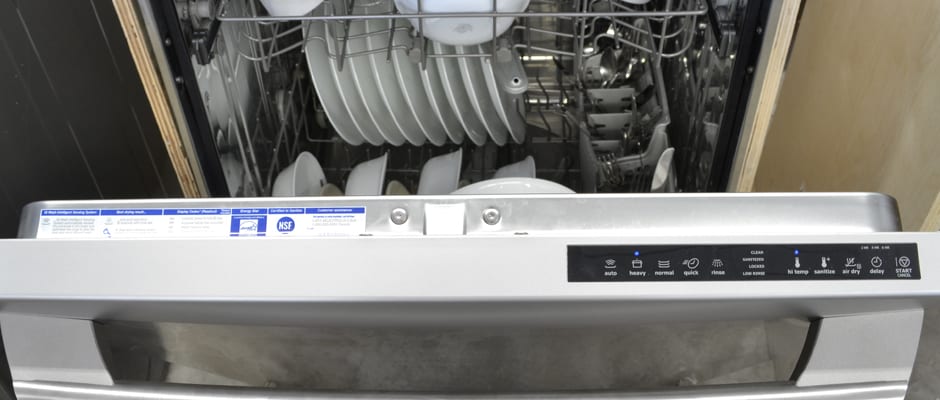Introduction
With an MSRP of $999 the {{product.model}} is costly, but we found it online for $899, which is still pretty steep.
Front
{{section_header}}{{section.name}}{{/section_header}}
Something about the front, with its rigid handle and off-color top trim, evoke power and control. And it feels as sturdy as it looks. The handle looks and feels like it could be used for military purposes, and the black control panel only compliments the sleek steel cover. As with professional bodybuilders, it’s okay to awe.
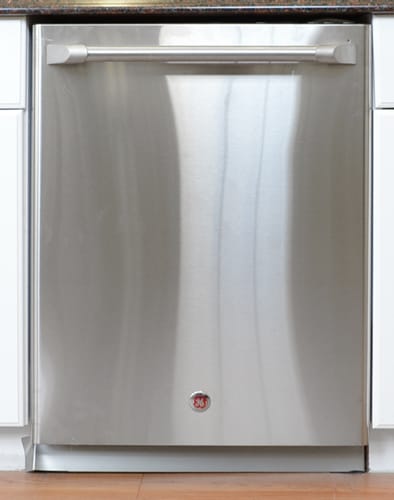
The front of the GE CDWT980VSS.
Finish
{{section_header}}{{section.name}}{{/section_header}}
The exterior finish is a brawny stainless steel that feels like it could withstand an artillery shelling.

Controls
{{section_header}}{{section.name}}{{/section_header}}
The black control panel is positioned at the top of the washer door and fits well with the stainless steel finish. All the options are clearly labeled, and there are blue lights to indicate selections and cycle progress.
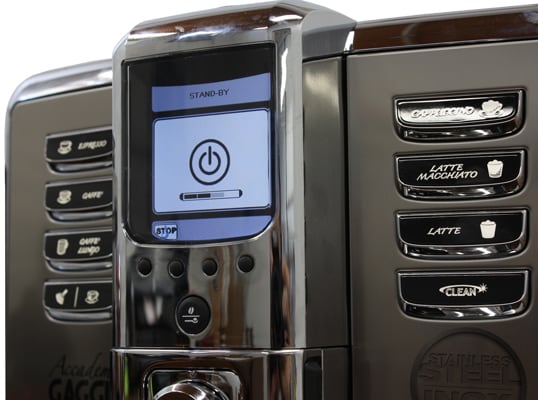
Interior
{{section_header}}{{section.name}}{{/section_header}}
The stainless steel wash tub helps to expedite the drying process, but it’s generally a run-of-the-mill interior. The dual-sided wash arms are nothing special, and the other accessories look like they’ve appeared in dishwashers since the dawn of time. Once again, this is a testament to the bodybuilder analogy: all girth and show on the outside, nothing special on the inside.
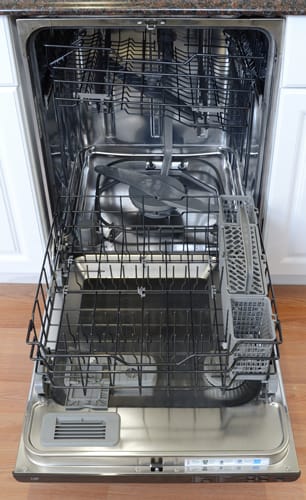
The CDWT980VSS with door open.
Top Rack
{{section_header}}{{section.name}}{{/section_header}}
{{product.brand.name}} isn’t trying to revolutionize the idea of loading dishes in a basket, but it shouldn’t be. It takes from its predecessors and works well. The material is sturdy, there’s a useful handle for sliding the top rack, and there are two foldable cutlery holders on either side.
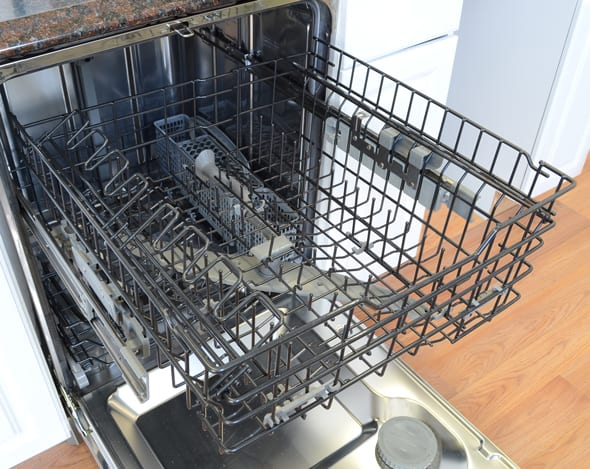
The top rack of the CDWT980VSS.
Bottom Rack
{{section_header}}{{section.name}}{{/section_header}}
Like the top rack, the bottom is to the point and functions as it needs to—no more, no less. There are plenty of tines, including two collapsible rows, and they’re angled to deliver added stability and flexibility.
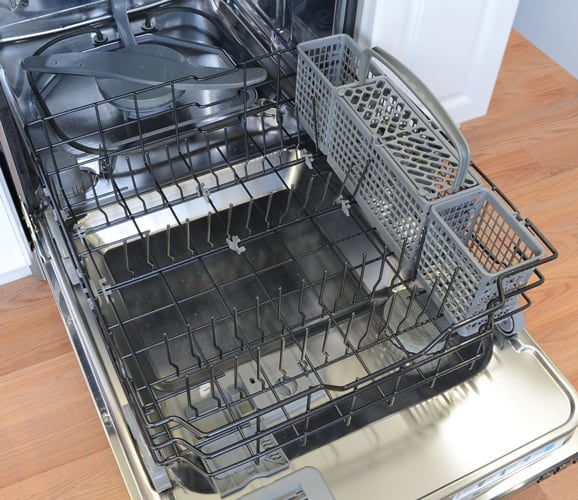
The bottom rack of the CDWT980VSS.
Cutlery Basket
{{section_header}}{{section.name}}{{/section_header}}
The cutlery basket seemed a bit large for our taste. It’s really big, offers more than enough space, and likely limits the machine’s capacity as a result. But if you’re looking for plenty of space for silverware and other kitchen utensils, this basket offers plenty of room and flexibility.
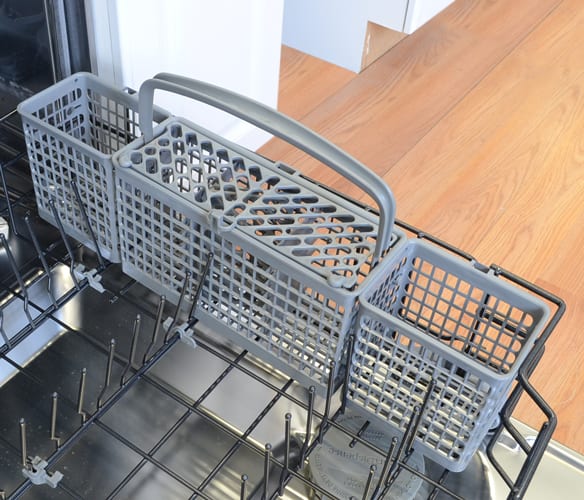
The CDWT980VSS cutlery basket.
Electricity Use
{{section_header}}{{section.name}}{{/section_header}}
The {{product.model}} performed well in regards to energy consumption. From the Quick Wash to the Heavy, it demanded 0.61 to 1.03 kWh’s per wash. That made for an electricity cost of 4 cents for a standard Quick Wash cycle, 6 for a Normal, and 11 for a Heavy. These figures are standard by most industry comparisons.
{{ attachments(510c33971aff3cd0770005f1)
Water Use
{{section_header}}{{section.name}}{{/section_header}}
This is where the {{product.model}}’s efficiency score suffered, as each cycle consumed a lot of water. The Quick Wash, which lasts a mere half-hour, soaked up a whopping 5.86 gallons of hot water. That figure fell slightly to 5.75 gallons on the Normal Wash (still pretty high), and then soared to 9.03 gallons on the Heavy Wash. These figures made for a water cost of 6 to 9 cents per wash, depending on the cycle.
Yearly Running Cost
{{section_header}}{{section.name}}{{/section_header}}
The {{product.model}}’s three main wash cycles will cost you roughly 13 to 24 cents per wash. Based on an average of using the Normal Wash 50 percent of the time, this makes for a running cost of $33.05 per year. While this isn’t a bad figure, per se, it definitely isn't great. Given the machine’s decent performance and impressive design, we were hoping for something better.
{{ attachments(50fc520abd02867055000830)
Washing Speed
{{section_header}}{{section.name}}{{/section_header}}
The progress of dishwasher technology has led to a sacrifice of speed in favor of performance—a fair trade, by most accounts. But the {{product.model}} is generally a fast machine. At 31 minutes, it truly lives up to the idea of a “Quick Wash” (unlike so many of its competitors). The Normal and Heavy Washes were also relatively fast, clocking in at 93 and 134 minutes, respectively.
{{ attachments(510c35ef1aff3cd077000641)
Washing Performance
{{section_header}}{{section.name}}{{/section_header}}
We noticed spinach stains seemed to find themselves baked onto dishware throughout the wash, regardless of cycle. This was a particular problem in heavier loads. However, the {{product.model}} performed very well on the Normal Wash. We concluded that it will handle small- and medium-sized stains like a champ; just don’t ask it to do any heavy lifting.
{{ attachments(50fc5205bd028692240007ed)
Quick Wash Cycle
{{section_header}}{{section.name}}{{/section_header}}
The Quick Wash was just plain bad. It received one of the lowest scores ever on our milk test (in which we bake milk onto glassware), and it was virtually useless in removing oatmeal stains. We imagine it would be sufficient for lightly soiled dishes that are manually scrubbed beforehand, but its half-hour speed was still not enough to give us an overall good impression.
{{ attachments(50fc5205bd028690490007eb)
Normal Wash Cycle
{{section_header}}{{section.name}}{{/section_header}}
The Normal Wash was by far the superior cycle; we would recommend using this option most frequently. Like the Quick Wash, it had some trouble on our oatmeal test, but it also did exceptionally well on our egg test (in which we bake egg batter onto spoons). Also, given the Normal Wash’s comparatively strong efficiency performance, it makes sense to clean most of your dishes with this cycle.
Normal Cycle
{{ attachments(510c395f15d62b6c290006f7)
Heavy/Pots & Pans Wash Cycle
{{section_header}}{{section.name}}{{/section_header}}
The Heavy Wash sprayed a considerable amount of food particles throughout the wash. Because these soils were so tiny, the overall clean of the dishes was thorough, but we aren't willing to go so far as to claim it was a market-leading heavy cycle. It did poorly on our baked lasagna tests, and it left our milk-stained glasses infused with tiny food specks that would fail to entice even a starving man. However, its high temperature ensured solid performance on proteins (such as egg and meat); it was just those tiny particles that we hated.
Pots & Pans Cycle
{{ attachments(50fc5205bd0286ff420007ee)
Washing Cycles
{{section_header}}{{section.name}}{{/section_header}}
The three main cycles—Quick, Normal, and Heavy—are complemented by a standard rinse option and an Auto Wash, which uses a sensor function to gauge the intensity of wash loads and then engage the appropriate cycle. While this leaves the amount of cycles somewhat bare, the range of effectiveness in the three main washes should suffice.
Customization
{{section_header}}{{section.name}}{{/section_header}}
The {{product.model}} includes a high-temperature wash and a sanitize feature, both of which do the same thing; they merely differ in the peak temperature they reach. The Hi-Temp option heats water to approximately 140 degrees in the main wash and 150 degrees in the final rinse.
We did a test of the Sanitize option on a Normal Wash and found it reached sufficiently high temperatures to kill bacteria (158.9 degrees); most bacteria succumb at around 155 degrees. However, this option also prolonged the cycle by nearly half-an-hour, and also consumed roughly 1.5 more gallons of water and 0.22 more kWh. This made for a cost per wash of about 18 cents (compared with 14 cents without the sanitize feature).
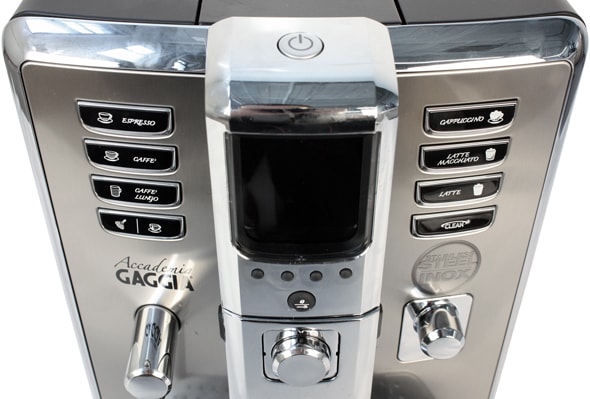
Additional Wash Options
{{section_header}}{{section.name}}{{/section_header}}
The {{product.model}} also includes a rinse cycle, which is used to clean off loose food soils in preparation for a more complete wash at a later time. There's an Auto Wash that adjusts cycle time and water consumption according to the volume of food soils in a load. The child control lock, which for some strange reason uses the same button as the Air Dry feature, may be a perk for young parents. And finally, there’s the delay feature, which allows you to postpone the start of a wash cycle by two, four, or six hours.

Capacity
{{section_header}}{{section.name}}{{/section_header}}
Reflecting its daunting appearance, the {{product.model}} has a large capacity. We were able to fit 11 place settings plus a serving setting. Even with the bulky cutlery basket we found this to be plenty of space for most dish loading needs.
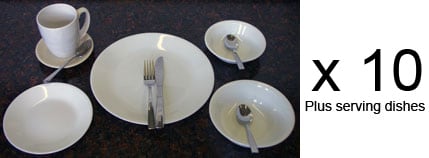
Top Rack
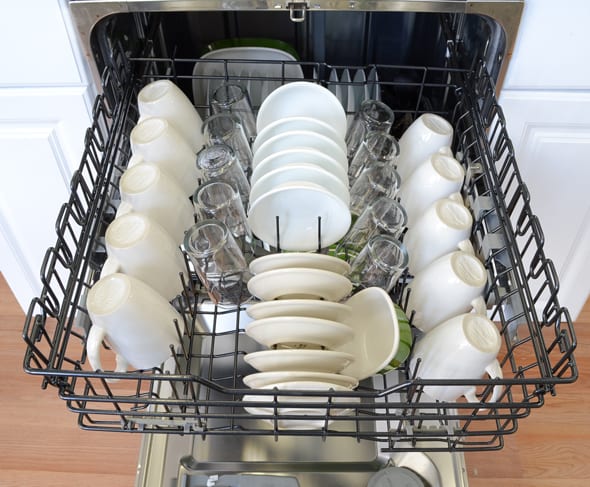
Bottom Rack
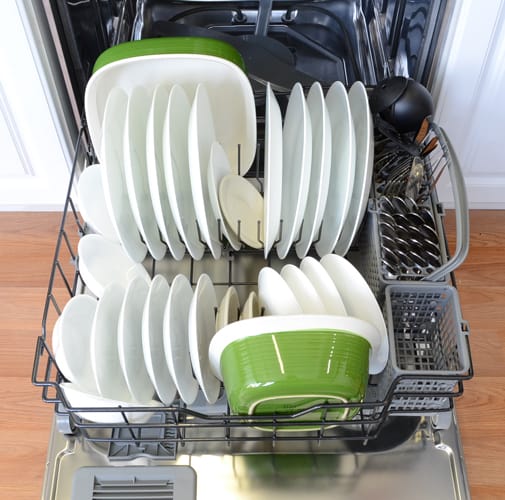
Wash Arms & Filters
{{section_header}}{{section.name}}{{/section_header}}
There are three wash arms, two beneath each rack plus a third on the ceiling of the wash tub. Each is made of plastic, but they feel sturdy and locked firmly in place.
The filtration system is impressive, although only one component (the "glass trap" filter) can be removed for manual cleaning. This is unlike most other machines, which allow you to remove finer cylindrical filters as well.
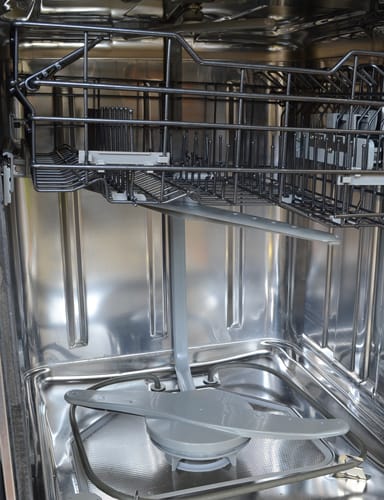
The CDWT980VSS wash arms.
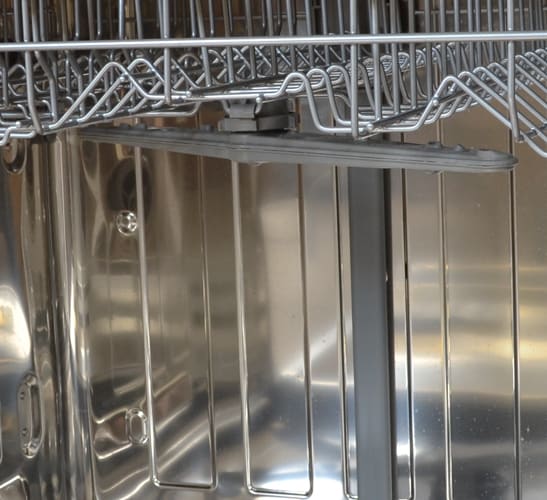
The DW 14140 upper wash arm
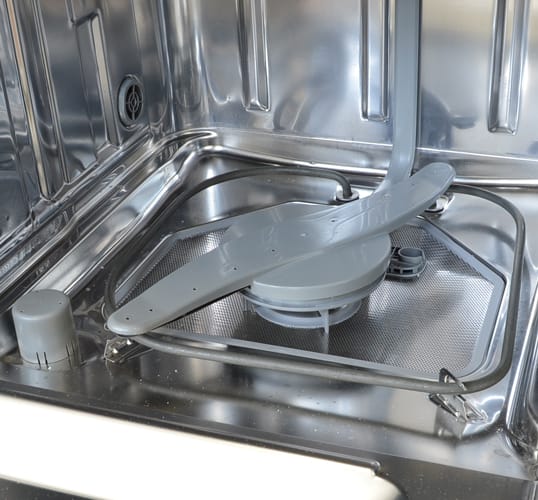
The CDWT980VSS filter.
Lower Dish Rack
{{section_header}}{{section.name}}{{/section_header}}
We found the bottom rack to be highly flexible and easy to use—a testament to the dishwasher’s overall high capacity. The evenly spaced tines and foldable rows allow dishes to slide in easily. They are also angled in such a way that bowls and other small dishes won’t slide face down on top of one another.

The bottom rack of the CDWT980VSS.
Upper Dish Rack
{{section_header}}{{section.name}}{{/section_header}}
The top rack is less adjustable than the bottom, but the layout and number of tines ensure equally strong flexibility and usability. This contributed to the machine's high capacity score.

The top rack of the CDWT980VSS.
Cutlery Holder
{{section_header}}{{section.name}}{{/section_header}}
It’s big. If you find this beast is too small to handle your cutlery loads then maybe you should use fewer spoons in you place settings. There are eight total interior bays, four of which are encased by foldable lids on both ends of the basket. Our one beef was that it only fits in one location on the bottom rack. If it were made just a little smaller you’d be able to fit it along the front or rear of the rack.

The CDWT980VSS cutlery basket.
Detergent Dispenser
{{section_header}}{{section.name}}{{/section_header}}
The detergent dispenser is standard. It includes one line for measuring your detergent level, and the rinse aid dispenser is enclosed by a twist-off cap.
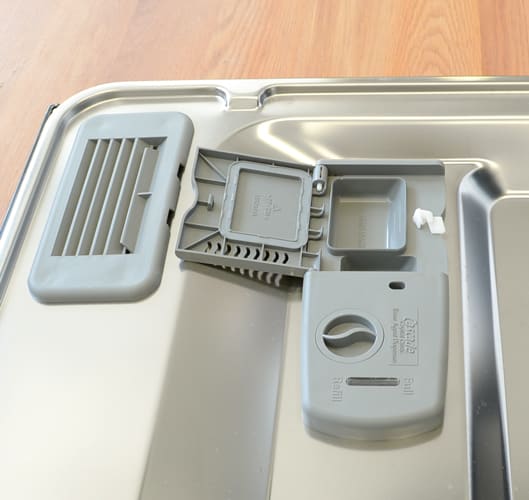
The CDWT980VSS detergent dispenser.
Ease of Use
{{section_header}}{{section.name}}{{/section_header}}
This machine is very easy to use. The simplicity and soft design of the interface really drive this point home, and the racks and cutlery basket are built so that fitting dish loads—no matter how awkward their shape—shouldn’t be much of a challenge.
Noise
{{section_header}}{{section.name}}{{/section_header}}
The {{product.model}} is pretty quiet, a bit more so than most other dishwashers in its price range. We can’t imagine anyone complaining about the volume.
Controls
{{section_header}}{{section.name}}{{/section_header}}
The buttons are a bit heavy, in that they seem to require more force than necessary, but the overall interface is tastefully designed with each option clearly labeled. There's also a display that highlights the progress or customization selections of each wash (Clean, Sanitized, Locked, Low Rinse).


Efficiency
{{section_header}}{{section.name}}{{/section_header}}
The {{product.model}} will cost you roughly $33.05 a year to operate. Most of this expense stems from its considerably high water consumption, which ranges from 5 to 9 gallons of hot water per wash. If it weren’t for its relatively low electricity use, this machine would rank among some of the least efficient models on the market.
Washing Performance
{{section_header}}{{section.name}}{{/section_header}}
The {{product.model}}’s robust design belies its mediocre performance. While the Normal Wash fared very well—and is the most important cycle—the Quick and Heavy Washes were somewhat disappointing; the former was just plain bad, and the latter had trouble achieving a spotless clean. All three cycles were fast, particularly the Quick Wash (at 31 minutes), but this wasn’t enough to impress us.
Features
{{section_header}}{{section.name}}{{/section_header}}
The {{product.name}} offers few extra features, but enough to keep users interested. There are two customization options: a high-temperature wash and a sanitize feature, both of which do essentially the same thing, which is to heat water. There’s also a delay option, an Auto Wash, a rinse cycle, and an air dry selection.
Meet the tester
Tyler Wells Lynch is a freelance writer and journalist whose work has appeared in Vice, Wirecutter, Gizmodo, The Rumpus, Yes!, and the Huffington Post, among others. He lives in Maine.
Checking our work.
Our team is here to help you buy the best stuff and love what you own. Our writers, editors, and experts obsess over the products we cover to make sure you're confident and satisfied. Have a different opinion about something we recommend? Email us and we'll compare notes.
Shoot us an email